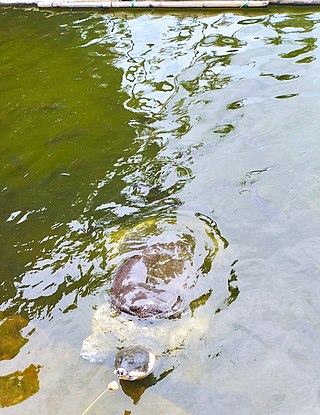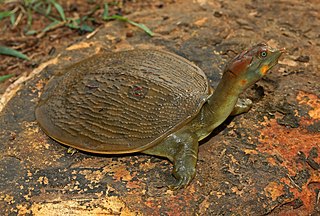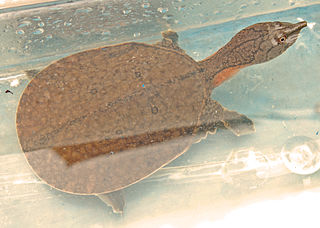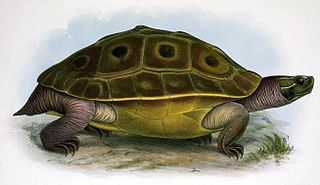
The Trionychidae are a taxonomic family of a number of turtle genera, commonly known as softshell turtles. The family was erected by Leopold Fitzinger in 1826. Softshells include some of the world's largest freshwater turtles, though many can adapt to living in highly brackish areas. Members of this family occur in Africa, Asia, and North America, with extinct species known from Australia. Most species have traditionally been included in the genus Trionyx, but the vast majority have since been moved to other genera. Among these are the North American Apalone softshells that were placed in Trionyx until 1987.

The Asian giant softshell turtle, also known commonly as Cantor's giant softshell turtle and the frog-faced softshell turtle, is a species of freshwater turtle in the family Trionychidae. The species is native to Southeast Asia. The species is critically endangered and in the 20th century has disappeared from much of its former range.

The black softshell turtle or Bostami turtle, previously placed in genus Aspideretes, is a species of freshwater turtle found in India and Bangladesh. It was long believed to be inbred individuals of the Indian softshell turtle or the Indian peacock softshell turtle, but while it is a close relative of the latter, it is a distinct species. In the 1800s it was believed these turtles were brought from Iran to Chittagong shrine pond by Hazrat Bayezid Bostami. His turtles he had brought to this pond were treated as sacred and respected by the public. Previously declared extinct by the International Union for Conservation of Nature in 2002, these turtles were found still to exist in a temple's pond called the Hayagriva Madhava Temple located in Assam, and in Kalyan Sagar lake in Tripura Sundari Temple in Udaipur, Tripura, India. Through conservation methods and protection of the species, some of these turtles can be found today throughout the wild, and scientists and environmental biologists are continuing to work hard to preserve this endangered species and their natural habitat. Their mitogenome represents relatedness to 19 other species of the Testudines. When looking at the phylogenetic tree, Nilssonia Nigricans are a species represented as sisters to Nilssonia formosa.

Leith's softshell turtle is a species of turtle in the family Trionychidae. The species is found in peninsular Indian rivers including the Bhavani, Godavari, and Moyariii Rivers. The types.... locality is Pune in India.

Indian peacock softshell turtle is a species of turtle found in South Asia, and is listed on the IUCN Red List as a vulnerable species.

The Indian softshell turtle, or Ganges softshell turtle is a species of softshell turtle found in South Asia in rivers such as the Ganges, Indus and Mahanadi. This vulnerable turtle reaches a carapace length of up to 94 cm (37 in). It feeds mostly on fish, amphibians, carrion and other animal matter, but also takes aquatic plants. This turtle is listed in part II of Schedule I of the Wild Life (Protection) Act, 1972 and possession of this species is an offence.

The Asian leaf turtle is a species of turtle found in Southeast Asia. They are quite common in the pet trade; their carapaces resemble that of a Cuora amboinensis hybrid.

Oldham's leaf turtle is a species of turtle in the family Geoemydidae.

The wattle-necked softshell turtle, also commonly known as Steindachner's soft-shelled turtle, is an endangered Asian species of softshell turtle in the family Trionychidae. The species is the only member of the genus Palea.

The Cuatro Ciénegas softshell, also called the black spiny softshell, is a subspecies of the spiny softshell turtle in the family Trionychidae. The subspecies, along with its parent species, was formerly classified in the genus Trionyx.

The Asian narrow-headed softshell turtle is a large species of softshell turtle in the family Trionychidae. The species is endemic to Southeast Asia.

The Malayan softshell turtle is a species of softshell turtle in the family Trionychidae. It is monotypic in its genus.

Nilssonia is a genus of softshell turtles from rivers, streams, ponds, and lakes in South Asia and Burma. In many treatments, it is monotypic, with the single species Burmese peacock softshell. However, the supposed other genus of peacock softshells, Aspideretes, is more closely related to N. formosa than had been believed. They differ only in the neural plates between the first pleural scale pair of the bony carapace, which are fused into one in N. formosa and unfused in the others.

The Burmese eyed turtle, also known as the Bengal eyed terrapin, Burmese peacock turtle or swamp turtle, is a species of turtle in the family Geoemydidae of southern Asia.

The big-headed turtle is a species of turtle in the family Platysternidae from Southeast Asia and southern China.

The African softshell turtle or Nile softshell turtle is a large species of turtle from fresh-water and brackish habitats in Africa and the Near East. It is the only extant species from the genus Trionyx, but in the past many other softshell turtles were placed in this genus; they have now been moved to various other genera. Despite the name "African softshell turtle", it is not the only species or genus of softshell turtle in Africa. It is a very large species of softshell turtle, with sizes that range from 85 to 94 cm, a weight of 40 kg, and an unconfirmed max size of 120 cm. They are omnivores in diet, consuming small fish, crustaceans, and also palm seeds and fallen leaves.
The Burmese narrow-headed softshell turtle, also known commonly as the Myanmar narrow-headed softshell turtle and Van Dijk's chitra, is a species of turtle in the family Trionychidae. The species is endemic to Southeast Asia.
The northern New Guinea giant softshell turtle is a species of turtle found in the lowlands of northern New Guinea. South of the Central Range it is replaced by the closely related southern New Guinea giant softshell turtle. It is threatened by overhunting and harvesting of eggs as well as significant habitat loss of aquatic vegetation due to introduced fish species such as the red-bellied pacu.
The lesser Chinese softshell turtle is a species of turtle in the family Trionychidae. It is endemic to China, where it inhabits a small range in Guangxi and Hunan provinces. Populations of this species in Vietnam and Hainan are now considered to belong to a separate species, the spotted softshell turtle. There is some controversy within researchers over whether or not P. parviformis is a valid species, but a study in 2015 reaffirmed it as such.

The Southeast Asian softshell turtle is a species of softshell turtle in the family Trionychidae.



















